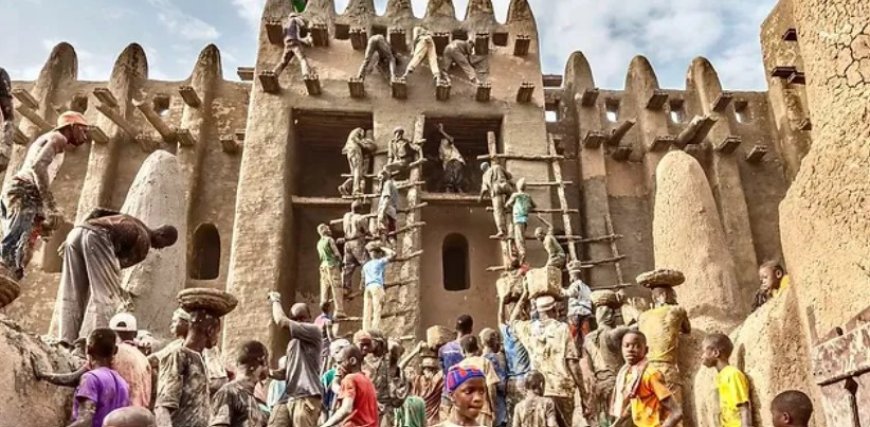Mali/ Restoring the Great Mosque of Djenné: A Cultural and Architectural Revival (video)
Summary & Description (Meta Tag)

In the heart of Mali, thousands of people, including numerous volunteers, are collaborating to restore one of the country's oldest and most prestigious mosques—the Great Mosque of Djenné. This mosque, recognized as the largest mud-brick building in the world, serves as a vital center for religious and cultural life in the region.
https://x.com/mog_china/status/1834573018598715828
The Restoration Process of the Great Mosque of Djenné
Annual Celebration: Crépissage
An annual event known as "Crépissage" is organized, where the town's residents come together to renew the mosque's walls using a special mixture of mud, water, and other components. This event is not merely a maintenance task but a celebration that strengthens social and cultural bonds within the community.
Community Participation
Men, women, and children participate in this event, reflecting the community's commitment to preserving their cultural and religious heritage. Residents from different neighborhoods compete to finish the work first, adding an atmosphere of enthusiasm and cooperation.
Significance of the Mosque
The Great Mosque of Djenné is not only an architectural landmark but also a symbol of Islamic history in West Africa. It was designated a UNESCO World Heritage Site in 1988.
Environmental Challenges
The mosque requires annual maintenance due to harsh climatic conditions. Renewing the walls helps protect the structure from erosion caused by heavy rains and high temperatures.
This collective effort embodies the community spirit and the commitment of new generations to preserve Mali's cultural and religious heritage.
Differences in Restoration: Djenné vs. Timbuktu
The restoration process of the mosque in Djenné differs from that of mosques in Timbuktu in several aspects, including methods, objectives, and cultural and historical contexts. Here are some key differences:
Historical and Cultural Context
-
Djenné: The Great Mosque is a significant symbol of Islamic mud architecture in West Africa, dating back to the 13th century. The restoration focuses on preserving its unique cultural and architectural heritage.
-
Timbuktu: Timbuktu houses a collection of historic Islamic landmarks, including mosques and libraries. Restoration efforts aim to protect cultural heritage from threats encountered during armed conflicts, especially in the last decade.
Methods Used
-
Djenné: Restoration relies on community-driven efforts, with thousands of volunteers renewing the mosque using traditional techniques like mud and water, enhancing social bonds.
-
Timbuktu: Restoration may involve interventions from international organizations and cultural institutions, along with modern techniques to preserve landmarks. Efforts also include documenting destroyed landmarks and recovering lost cultural materials.
Objectives
-
Djenné: The primary goal is to preserve the mosque as part of the region's cultural and religious identity and to foster community spirit through collective work.
-
Timbuktu: Restoration aims to protect cultural heritage from destruction, promote cultural tourism, and restore the city's historical identity after years of conflict.
Challenges
-
Djenné: Restoration may face challenges related to funding and resources but enjoys strong community support.
-
Timbuktu: Restoration faces greater challenges due to volatile security and political conditions, along with a lack of external resources and funding.
Overall, both restoration efforts reflect local communities' commitment to preserving their cultural heritage, but they differ in methods, objectives, and contexts.
Technical Challenges in Restoring Djenné's Mosque
The restoration of the mosque in Djenné encounters several technical challenges, including:
Materials Used
- Mud: The mosque's construction relies on mud as a primary material, requiring large quantities of high-quality mud. The mud must be suitable in composition and properties to ensure the building's sustainability.
Traditional Techniques
- Manual Techniques: Restoration relies on traditional building techniques, requiring specialized skills from workers and volunteers. There may be a lack of expertise or training necessary to ensure proper execution.
Climatic Conditions
- Climate Changes: Construction processes are exposed to weather factors such as rain and heat, which may affect the quality of materials used. Measures must be taken to protect completed work from harsh weather conditions.
Preserving Original Character
- Consistency with Original Design: It is essential to maintain the mosque's original architectural character during restoration, requiring precision in execution and a deep understanding of traditional design.
Logistical Challenges
- Material Transportation: Restoration may face challenges in transporting materials to the site, especially if the area is remote or suffers from weak infrastructure.
Funding and Support
- Financial Resources: Restoration efforts require sufficient funding to cover material and labor costs. Securing necessary funding may be difficult, affecting the pace of work.
Coordination Among Teams
- Volunteer Cooperation: Collective work requires effective coordination among different volunteer teams, which can sometimes be challenging.
The restoration of the mosque in Djenné requires effectively addressing these technical challenges to ensure the project's success and the preservation of this important historical landmark.

